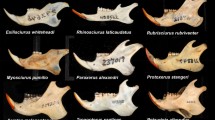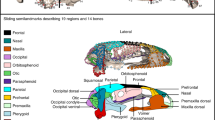Abstract
I address the question of how fluctuating asymmetry (FA)—the distribution of random deviations from bilateral symmetry—varies ontogenetically in the mammalian skeleton. This question is significant because of the light that such patterns can shed on the causes of variation in developmental stability in bone as well as other structures. Based on large ontogenetic skeletal series of Macaca mulatta and Homo sapiens, I report that the FA variances of skeletal metric traits increase ontogenetically. Coupled with the finding that FA variances also accumulate to greater magnitudes in slower growing mammals, this result is consistent with the hypotheses that FA in bone is primarily caused by (a) cumulative effects of asymmetrical mechanical factors, (b) accumulation of variation in the (local) regulation of growth, or (c) a tendency for bone morphology to drift through undirected remodeling. I discuss the implications of these optional explanations for primate evolution and bone development.
Similar content being viewed by others
REFERENCES
Atchley, W. R., Gaskins, G. T., and Anderson, D. (1976). Statistical properties of ratios. I. empirical results. Syst. Zool. 25: 137-148.
Cheverud, J. M. (1995). Morphological integration in the saddle-back tamarin (Saguinus fuscicollis) cranium. Am. Nat. 145: 63-89.
Ferguson, M. M. (1985). Developmental stability of rainbow trout hybrids: Genomic coadaptation or heterozygosity. Evolution 40: 323-330.
Finch, J. (1990). Longevity, Senescence and the Genome, University of Chicago Press, Chicago.
Fischer, R. B., Meunier, G. F., and White, P. J. (1982). Evidence of laterality in the lowland gorilla. Perc. Motor Skills 54: 1093-1094.
Frost, H. M. (1964). The Laws of Bone Structure, Charles C Thomas, Springfield, IL.
Garn, S. M., Lewis, A. B., and Kerewsky, R. S. (1967). Buccolingual size asymmetry in the permanent dentition. Angle Orthod. 37: 186-193.
Gavan, J. A. (1953). Growth and development of the chimpanzee: A longitudinal and comparative study. Hum. Biol. 25.
Gundberg, C. M., Anderson, M., and Dickson, I. (1986). Glycated osteocalcin in human and bovine bone. J. Biol. Chem. 261: 14557-14561.
Hall, B. K., and Miyake, T. (1995). How do embryos measure time. In McNamara, K. J. (ed.), Evolutionary Change and Heterochrony, John Wiley & Sons, Chichester, pp. 4-20.
Hallgrímsson, B. (1993a). Fluctuating asymmetry in Macaca fascicularis: A study of the etiology of developmental noise. Int. J. Primatol. 14: 421-443.
Hallgrímsson, B. (1993b). Fluctuating asymmetry in Macaca fascicularis: Implications for the etiology of developmental noise. Suppl. 16: 102.
Hallgrímsson, B. (1995). Fluctuating Asymmetry and Maturational Spans in Mammals: Implications for the Evolution of Prolonged Development in Primates, Ph.D. thesis, University of chicago, Chicago.
Hallgrímsson, B. (1997). Fluctuating asymmetry in the mammalian skeleton: Evolutionary and developmental implications. In Hecht, M. K., and Clegg, M. T. (eds.), Evolutionary Biology, Vol. 30, pp. 187-251.
Herring, S. (1993). Formation of the vertebrate face: Epigenetic and functional influences. Am. Zool. 33: 472-483.
Hershkovitz, I., Livshits, G., Moskona, D., Arensburg, B., and Kobyliansky, E. (1993). Variables affecting dental fluctuating asymmetry in human isolates. Am. J. Phys. Anthropol. 91: 349-365.
Katz, D., and Suchey, J. M. (1986). Age determination of the male Os Pubis. 69: 427-435.
Kobyliansky, E., and Livshits, G. (1989). Age dependent changes in morphometric and biochemical. Ann. Hum. Biol. 16(3): 237-247.
Lande, R. (1977). On comparing coefficients of variation. Syst. Zool. 26: 214-217.
Lanyon, L. E. (1992). The success and failure of the adaptive response to functional load-bearing in averting bone fracture. Bone 13: s17-s21.
Livshits, G., and Kobyliansky, E. (1991). Fluctuating asymmetry as a possible measure of developmental homeostasis in humans: A review. Hum. Biol. 63: 441-466.
Manly, B. F. J. (1991). Randomization and Monte Carlo Methods in Biology, Chapman and Hall, London.
Manning, J. T., and Chamberlain, A. T. (1994). Fluctuating asymmetry in Gorilla canines: A sensitive indicator of environmental stress. Proc. R. Soc. Lond. B. Biol. Sci. 255(1343): 189-193.
Manning, J. T., and Ockenden, L. (1994). Fluctuating asymmetry in racehorses. Nature 370: 185-186.
Miyake, T., Cameron, A. M., and Hall, B. K. (1996). Detailed staging of inbred C57BL/6 mice between Theiler's [1972] stages 18 and 21 (11–13 days of gestation) based on craniofacial development. J. Craniofac. Genet. Dev. Biol. 16: 1-31.
Moller, A. P. (1991). Sexual ornament size and the cost of fluctuating asymmetry. Proc. R. Soc. Lond. B 243: 59-62.
Moller, A. P., and Hoglund, J. (1991). Patterns of fluctuating asymmetry in avian feather ornaments—Implications for models of sexual selection. Proc R. Soc. Lond. B 245(1312): 1-5.
Moore, W. J. (1965). Masticatory function and skull growth. J. Zool. 146: 123-131.
Moore, W. J. (1973). An experimental study of the functional components of growth in the rat mandible. Acta Anat. 85: 378-385.
Moss, M. L. (1968). The primacy of functional components in orofacial growth. Dent. Pract. 19: 56-73.
Moss, M. L. (1972a). functional cranial analysis and the functional matrix. In Schumacher, G.-H. (ed.), Morphology of the Maxillo-Mandibular Apparatus, Veb Georg Thieme, Leipzig, pp. 160-165.
Moss, M. L. (1972b). The regulation of skeletal growth. In Goss, R. (ed.), Regulation of Organ and Tissue Growth, Academic Press, New York, pp. 59-66.
Moss, M., and Meehan, M.-A. (1970). Functional cranial analysis of the coronoid process in the rat. Acta Anat. 77: 11-24.
Nonaka, K., and Nakata, M. (1984). Genetic variation and craniofacial growth in inbred rats. J. Craniofac. Genet. Dev. Biol. 4: 271-302.
Noss, J. F., Scott, G. R., Yap Potter, R. H., and Dahlberg, A. (1983). fluctuating asymmetry in molar dimensions and discrete morphological traits in Pima Indians. Am. J. Phys. Anthropol. 61: 437-445.
Novak, J. M., Rhodes, O. E., Smith, M. H., and Chesser, R. K. (1993). Morphological asymmetry in mammals: Genetics and homeostasis reconsidered. Acta Theriol. 38: 7-18.
Palmer, A. R., and Strobeck, C. (1986). Fluctuating asymmetry: Measurement, analysis, patterns. 17: 391-421.
Patterson, B. D., and Patton, J. L. (1990). Fluctuating asymmetry and allozymic heterozygosity among natural populations of pocket gophers (Thomomys bottae'). Biol. J. Linn. Soc. 40:21-36. @ref alpha = Rawlins, R. G., and Kessler, M. J. (1986). Demography of the free-ranging Cayo Santiago macaques. In Rawlins, R. G., and Kessler, M. J. (eds.), The Cayo Santiago Macaques. State University of New York Press, Albany, pp. 47–72.
Reeve, E. C. R., and Robertson, F. W. (1953). Analysis of environmental variability in quantitative inheritance. Nature 171: 874-875.
Roth, V. L. (1989). Fabricational noise in elephant dentitions. Paleobiology 15: 165-179.
Rothstein, M. (1985). The alteration of enzymes in aging. Modern Aging Res. 7: 53-67.
Rubin, C. T., and Lanyon, L. E. (1984). Regulation of bone formation by applied dynamic loads. J. Bone Joint. Surg. 66A: 397-402.
Sacher, G. A. (1959). Relation of lifespan to brain weight and body weight in mammals. GIBA Foundation Symposium on the Lifespan of Animals.
Sacher, G. A. (1975). Maturation and longevity in relation to cranial capacity in hominoid evolution. In Tuttle, R. H. (ed.), Primate Functional Morphology and Evolution, Mouton, The Hague, Paris, pp. 417-442.
Saunders, S. R., and Mayhall, J. T. (1982). Fluctuating asymmetry of dental morphological traits: New interpretations. Hum. Biol. 54: 789-799.
Schmalhausen, I. I. (1949). Factors of Evolution, University of Chicago Press, Chicago.
Siegel, M. I., Mooney, M. P., and Taylor, A. B. (1992). Dental and skeletal reduction as a consequence of environmental stress. Acta Zool. Fenn. 191: 145-149.
Simmons, K. (1929). Cranial capacities by both plastic and water techniques with cranial linear measurements of the Reserve collection; White and Negro. Hum. Biol. 473-498.
Smith, B. H. (1991). Dental development and the evolution of life history in Hominidae. Am. J. Phys. Anthropol. 86: 157-174.
Sokal, R. R., and Rohlf, F. J. (1981). Biometry, W. H. Freeman;, New York.
Tanner, J. M. (1978). Fetus into Man, Harvard University Press, Cambridge, MA.
Van Valen, L. M. (1962). A study of fluctuation asymmetry. Evolution 16: 125-142.
Van Valen, L. M. (1978). The statistics of variation. Evol. Theory 4: 33-43.
Waddington, C. H. (1957). The Strategy of the Genes, Macmillan, New York.
Wagenen, G. V., and Catchpole, H. R. (1956). Growth of the fetus and placenta of the monkey (Macaca mulatta). Am. J. Phys. Anthropol. 23: 23-34.
Wakefield, J., Harris, K., and Markow, T. A. (1993). Parental age and developmental stability in Drosophila melanogaster. Genetica 89: 235-244.
Watts, E. S. (1986). Skeletal development. In Dukelow, W., and Erwin, J. (eds.), Comparative Primate Biology, Vol. 3. Reproduction and Development, Alan R. Liss, New York, 415-439.
Wayne, R. K., Modi, W. S., and O'Brien, S. J. (1986). Morphological variability and asymmetry in the cheetah (Acinonyx jubatus), A genetically uniform species. Evolution 40: 78-85.
Wootton, J. T. (1986). The effects of body mass, phylogeny, habitat, and trophic level on mammalian age at first reproduction. Evolution 41: 732-749.
Zakharov, V. M. (1992). Population phenogenetics: Analysis of developmental stability in natural populations. Acta Zool. Fennica 191: 7-30.
Zelditch, M. L., Bookstein, F. L., and Lundrigan, B. L. (1992). Ontogeny of integrated skull growth in the cotton rat Sigmodon fulviventer. Evolution 46: 1164-1180.
Zelditch, M. L., Bookstein, F. L., and Lundrigan, B. L. (1993). The ontogenetic complexity of developmental constraints. J. Evol. Biol. 6: 621-641.
Author information
Authors and Affiliations
Rights and permissions
About this article
Cite this article
Hallgrímsson, B. Ontogenetic Patterning of Skeletal Fluctuating Asymmetry in Rhesus Macaques and Humans: Evolutionary and Developmental Implications. International Journal of Primatology 20, 121–151 (1999). https://doi.org/10.1023/A:1020540418554
Issue Date:
DOI: https://doi.org/10.1023/A:1020540418554




